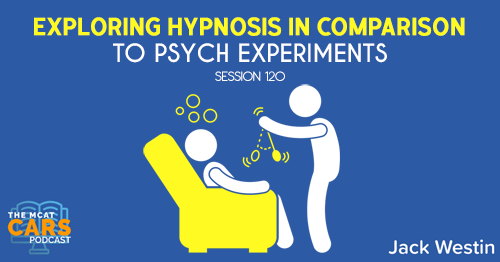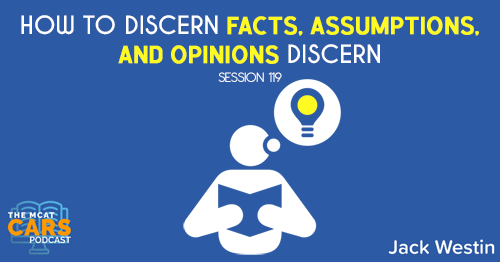Apple Podcasts | Google Podcasts

Session 66
Today, we read about fancy shoes that were banned in 15th-century London. We identify the point of the article and how to answer vague MCAT questions on it. As always, we’re joined by Jack Westin, the premier MCAT CARS tutor. Also, check out The MCAT Podcast along with all our other podcasts on Meded Media.
Listen to this podcast episode with the player above, or keep reading for the highlights and takeaway points.
Link to article:
https://www.atlasobscura.com/articles/medieval-europeans-pointy-shoes
In 1463, London outlawed the shoes of its fanciest men. These dapper lords had grown ridiculous in their dapperness, and had taken to ambling streets shod in long, carrot-shaped shoes that tapered to impish tips, some as long as five inches beyond the toe. These shoes were called “crakows” or “poulaines” (a term also used to refer to the tips alone), and the court of King Edward IV eventually found them offensive enough to pass a sumptuary law prohibiting shoe tips that extended over two inches beyond the toe.
Perhaps one of the silliest and most fascinating trends in medieval fashion, these shoes probably first emerged around 1340 in Krakow, Poland—both names refer to this origin—according to Rebecca Shawcross, the author of Shoes: An Illustrated History. Shawcross also serves as the shoe resources officer at Northampton Museum and Art Gallery in England, which claims to have the world’s largest collection of shoes (at 12,000 pairs, but alas, just one intact pair of poulaines).
Europe had flirted with long-toed footwear since the 1200s, but never to this length, or with this saturation. The lords and, to a lesser extent, ladies of 15th-century Europe wore these shoes almost exclusively for over a century. Every person who could afford shoes wore poulaines, though the longer tips were generally reserved for nobility who could afford to wander around in footwear seemingly designed for pratfalls.
For the glitterati of medieval Europe, poulaines were less a fad than a symbol. “If you were a man of status and you had enough wealth, you wanted to show that off,” Shawcross says. “And to do that, you had to take the toe to the extreme.” Shoes with absurdly long toes were expensive and would clearly impair the wearer from efficiently partaking in any kind of physical labor. So they were also an indicator of leisure and luxury, free of extraneous effort or the tyranny of practicality.
Poulaines—like babies or uncorseted bosoms—could not support themselves. In order to keep the tips erect, medieval shoemakers stuffed them with soft organic material, often moss, hair, or wool. “Without a stuffed toe, it gets quite floppy,” Shawcross says. “It doesn’t look like it would have been worn by someone of status at all.” The material also helped prevent the tip of the poulaine from curling when wet, according to Jackie Keily, senior curator at the Museum of London, which boasts one of the most impressive collections of poulaines. One shoe in particular, recovered from an archaeological excavation on the waterfront, boasts a modest tip but a delicate leaf pattern.
[03:37] Paragraph 1, Sentence 1
In 1463, London outlawed the shoes of its fanciest men.
Jack says:
We’re given the time and setting here. The fancy men refer to rich people.
[04:04] Paragraph 1, Sentence 2
These dapper lords had grown ridiculous in their dapperness, and had taken to ambling streets shod in long, carrot-shaped shoes that tapered to impish tips, some as long as five inches beyond the toe.
Jack says:
The author is giving a description of what these shoes look like.
[04:35] Paragraph 1, Sentence 3
These shoes were called “crakows” or “poulaines” (a term also used to refer to the tips alone), and the court of King Edward IV eventually found them offensive enough to pass a sumptuary law prohibiting shoe tips that extended over two inches beyond the toe.
Jack says:
We’re given more history about the shoes here, some terms, and the law.
[05:52] Paragraph 2, Sentence 1
Perhaps one of the silliest and most fascinating trends in medieval fashion, these shoes probably first emerged around 1340 in Krakow, Poland—both names refer to this origin—according to Rebecca Shawcross, the author of Shoes: An Illustrated History.
Jack says:
We’re given a bit of history of the shoes, where they came from and where the names came from as well.
[06:22] Paragraph 2, Sentence 2
Shawcross also serves as the shoe resources officer at Northampton Museum and Art Gallery in England, which claims to have the world’s largest collection of shoes (at 12,000 pairs, but alas, just one intact pair of poulaines).
Jack says:
Shawcross is part of the museum that has a lot of shoes but there’s only one pair of poulaines. So it seems like a rare thing with only one of them out of 12,000.
[06:57] Paragraph 3, Sentence 1
Europe had flirted with long-toed footwear since the 1200s, but never to this length, or with this saturation.
Jack says:
The shoe first emerged in 1340 but there were other similar shoes that were trying to gain some popularity although not as much.
[07:40] Paragraph 3, Sentence 2
The lords and, to a lesser extent, ladies of 15th-century Europe wore these shoes almost exclusively for over a century.
Jack says:
More lords than ladies were wearing these shoes a lot.
[08:00] Paragraph 3, Sentence 3
Every person who could afford shoes wore poulaines, though the longer tips were generally reserved for nobility who could afford to wander around in footwear seemingly designed for pratfalls.
Jack says:
If you could afford shoes, you’d be wearing these fancy poulaines. But the longer the tip, the more noble.
[08:47] Paragraph 4, Sentence 1
For the glitterati of medieval Europe, poulaines were less a fad than a symbol.
Jack says:
It wasn’t just a fancy thing people were wearing, but a symbol of how rich you were.
[09:10] Paragraph 4, Sentence 2
“If you were a man of status and you had enough wealth, you wanted to show that off,” Shawcross says.
Jack says:
This further explains the previous sentence.
[09:20] Paragraph 4, Sentence 3
“And to do that, you had to take the toe to the extreme.”
Jack says:
The more extreme, the wealthier you were.
[09:32] Paragraph 4, Sentence 4
Shoes with absurdly long toes were expensive and would clearly impair the wearer from efficiently partaking in any kind of physical labor.
Jack says:
People wearing these would be so difficult for them to walk.
[09:55] Paragraph 4, Sentence 5
So they were also an indicator of leisure and luxury, free of extraneous effort or the tyranny of practicality.
Jack says:
This paragraph points out to the first sentence that the shoes are a symbol of wealth as well as relaxation since you don’t need to work.
There are words in this paragraph that might throw you off. If you’re too tied up on the word “poulaines,” you might lose focus on what really matters. But so far, this has been an easy read.
[10:35] Paragraph 5, Sentence 1
Poulaines—like babies or uncorseted bosoms—could not support themselves.
Jack says:
The author is correlating the shoes to the babies.
[10:49] Paragraph 5, Sentence 2
In order to keep the tips erect, medieval shoemakers stuffed them with soft organic material, often moss, hair, or wool.
Jack says:
The author is painting a picture of how the shoes were made.
[11:03] Paragraph 5, Sentence 3
“Without a stuffed toe, it gets quite floppy,” Shawcross says.
Jack says:
Another description of the shoes.
[11:11] Paragraph 5, Sentence 4
“It doesn’t look like it would have been worn by someone of status at all.”
Jack says:
It doesn’t look like someone rich would wear them.
[11:50] Paragraph 5, Sentence 5
The material also helped prevent the tip of the poulaine from curling when wet, according to Jackie Keily, senior curator at the Museum of London, which boasts one of the most impressive collections of poulaines.
Jack says:
The author is mentioning is another person here who’s a senior curator describing the shoes more and how these were made.
[12:20] Paragraph 5, Sentence 6
One shoe in particular, recovered from an archaeological excavation on the waterfront, boasts a modest tip but a delicate leaf pattern.
Jack says:
The author is giving an example of what the shoe looked like. This paragraph talks about how the shoes need support and other stuff to keep the tip from curling.
[13:22] The Main Idea
The main point of the article is the history of how a lot of wealthy people wore them. It made them look good and seem like they’re better or richer. Basically, Medieval Europeans wore these shoes to show that they were wealthy. Everything else around it was just more filler which doesn’t affect the argument as much.
[14:25] Possible Question on the MCAT
The MCAT may not necessarily have an article like this. But if so, they may mention what makes poulaines important or why people wear poulaines. They will get to the root of the argument. You have to know it’s because of the symbol or the status.
'Usually, the easier reads like this will have really big questions.'Click To TweetA lot of students students struggle with big questions. The best way to get to the right answer for passages like this is to really stick to whatever the author said. Visualize the passage. Try to think what would the author pick in this case. It may seem outlandish and weird but the answer choices almost always are. As long as you stay consistent with that, you’re going to be fine.
They’re going to ask vague questions. For example, how people back them perceived people wearing those shoes. You have to go based on what you’ve read and nothing else.
Don’t bring in your outside knowledge. If you bring in your bias and your opinions about this kind of shoes, this could alter the way you answer questions so be careful with that.
[16:08] Check Out Jack Westin’s Trial Session
Check out the CARS strategy course to see how Jack Westin teachers and how the course functions. The lesson takes about an hour and a half. Get familiar with how the MCAT, specifically CARS, works. Hear how students in the course would go through a lesson. Take notes to understand new strategies and how to approach passages.
The course is a very good introduction to CARS in general. This is intended for students who just want to see how Jack teaches and how the course can get interactive. See if this is something that fits you and where you are in your studies.
Sign up for their free trial session and reserve a spot as they only have limited seats. Also, check out their free daily CARS passages.
Links:
Link to article:
https://www.atlasobscura.com/articles/medieval-europeans-pointy-shoes
SEARCH SITE
SEARCH SITE
LISTEN FOR FREE











